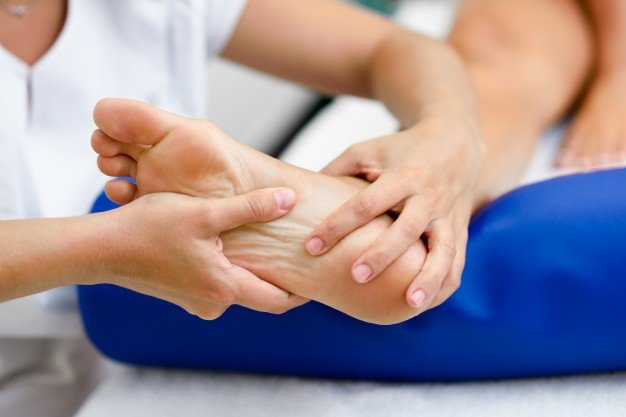If you ever had a sharp pain in the heel of your foot first thing in the morning when you get out of bed or after a long day of standing on your feet there’s a good chance you may have Plantar Fasciitis.
Plantar Fasciitis is a common overuse injury that causes pain under the heel of your foot. This painful area in the foot is situated about five centimetres from the back of the heel.
What causes Plantar Fasciitis?
Plantar Fasciitis is an inflammation of the site where a long fibrous band of tissue ligament called the plantar fascia attaches to the main heel bone also known as the calcaneus. The plantar fascia supports the muscles of the arch and foot. When they become overstretched, small tears can occur causing pain and inflammation of the heel. You are at higher risk of developing Plantar fasciitis if you have the following:
- Overweight or are standing on your feet all day.
- Runners or athletes who take off quickly.
- Have flat feet or very high arches.
- Have an unusual gait or incorrect biomechanics.
- Worn out shoes or not enough support for your arches in shoes.
- Tight Achilles tendon and calf muscles.
What are the symptoms?
- Pain under the heel is worse when you get out of bed first thing in the morning or pain when you stand up after a long time of sitting down.
- Heel pain after a long day of standing or walking.
- The bottom of the heel is painful to touch.
- X-rays may show a small spur on the bone.
What is the best treatment for Plantar Fasciitis?
- Resting from long walks and running is very important.
- Hot and cold therapy- this involves placing your foot in hot and then very cold water for 3o seconds for 15 minutes everyday.
- Nonsteroidal anti-inflammatory drugs (NSIADs) helps with decreasing inflammation and pain of plantar fasciitis prescribed by your doctor.
- If you have severe pain and it doesn’t respond to NSAID’s your doctor may give you a steroid injection. This steroid injection is injected into the plantar fascia and can be very painful. The effects of this steroid injection will last approximately four weeks by reducing the pain and inflammation.
- Wearing supportive footwear with arch support. A podiatrist will be able to design the correct type of orthotics based on your gait and posture. Having this arch support will help relieve pain and discomfort when walking and standing.
- Stretching exercises should be performed three times per day to stretch the plantar fascia and allow it to heal. One of the most effective exercises is to find a step and stand on it with the balls of feet. Keeping your knees straight slowly drop your heels gently. Hold this stretch for 25 seconds and repeat three times.
Remedial Massage helps stimulate blood flow and circulation to release the muscle tension, break down scar tissue of the plantar fascia. Deep tissue massage is effective for treating plantar fasciitis as it breaks down the adhesions that are formed by muscle tissues in the muscles caused by over exertion or strain of the plantar fascia. If you suffer from the discomfort of plantar fasciitis and would like a specific treatment program tailored to you please contact us at Phillip Island Massage Therapy.

